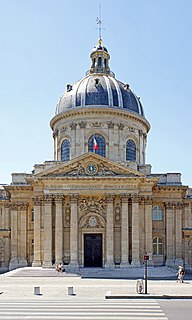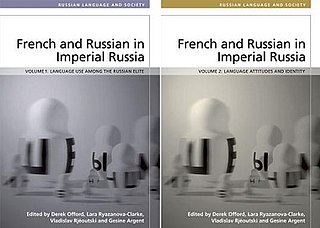 W
WFrench is a Romance language of the Indo-European family. It descended from the Vulgar Latin of the Roman Empire, as did all Romance languages. French evolved from Gallo-Romance, the Latin spoken in Gaul, and more specifically in Northern Gaul. Its closest relatives are the other langues d'oïl—languages historically spoken in northern France and in southern Belgium, which French (Francien) largely supplanted. French was also influenced by native Celtic languages of Northern Roman Gaul like Gallia Belgica and by the (Germanic) Frankish language of the post-Roman Frankish invaders. Today, owing to France's past overseas expansion, there are numerous French-based creole languages, most notably Haitian Creole. A French-speaking person or nation may be referred to as Francophone in both English and French.
 W
WThe Académie Française, also known as the French Academy, is the principal French council for matters pertaining to the French language. The Académie was officially established in 1635 by Cardinal Richelieu, the chief minister to King Louis XIII. Suppressed in 1793 during the French Revolution, it was restored as a division of the Institut de France in 1803 by Napoleon Bonaparte. It is the oldest of the five académies of the institute.
 W
WBelgian French is the variety of French spoken mainly among the French Community of Belgium, alongside related Oïl languages of the region such as Walloon, Picard, Champenois and Lorrain (Gaumais). The French language spoken in Belgium differs very little from that of France or Switzerland. It is characterized by the use of some terms that are considered archaic in France, as well as loanwords from languages such as Walloon, Picard and Dutch.
 W
WA belgicism is a word, expression, or turn of phrase that is unique to Belgian French. Even though the French spoken in Belgium is closer to the French spoken in France than the French spoken by Québécois, there are a considerable number of words and phrases that have disappeared from common usage in other Francophone nations that remain common in everyday Belgian speech.
 W
WCanadian French is the French language as it is spoken in Canada. It includes multiple varieties, the most prominent being Québécois. Formerly Canadian French referred solely to Quebec French and the closely related varieties of Ontario (Franco-Ontarian) and Western Canada—in contrast with Acadian French, which is spoken by Acadians in New Brunswick and some areas of Nova Scotia. PEI and Newfoundland & Labrador have Newfoundland French.
 W
WVarieties of the French language are spoken in France and around the world. The Francophones of France generally use Metropolitan French although some also use regional dialects or varieties such as Meridional French. In Europe outside France there are Belgian French, Swiss French, and in Italy Aostan French. In Canada, French is an official language along with English; the two main dialects of French in Canada are Quebec French and Acadian French, but also another dialect commonly grouped as Canadian French, used by Anglophones speaking French as a second language or by Francophones in Canada using a different dialect. In Lebanon, French was an official language until 1941 and the main dialect spoken there is Lebanese French or Levantine French. Note that the discussion here refers to varieties of the French language, not to the Romance sister languages of French spoken in France. See also French-based creole languages, which are also considered separate languages.
 W
WFrench and Russian in Imperial Russia is a two-volume non-fiction series published in 2015 by Edinburgh University Press. The volumes were edited by Derek Offord, Lara Ryazanova-Clarke, Vladislav Rjéoutski, and Gesine Argent. The two volumes are about language usage in the Russian Empire.
 W
WFrench Braille is the original braille alphabet, and the basis of all others. The alphabetic order of French has become the basis of the international braille convention, used by most braille alphabets around the world. However, only the 25 basic letters of the French alphabet plus w have become internationalized; the additional letters are largely restricted to French Braille and the alphabets of some neighboring European countries.
 W
WThe International Francophone Press Union is a Francophone association of journalists. Founded in 1950, it is the world's oldest Francophone organisation, and has more than 3,000 members in 110 countries.
 W
WThe Latin Union is an international organization of nations that use Romance languages, whose activities are suspended since 2012. Headquartered in Paris, France, its aim is to protect, project, and promote the common cultural heritage of Romance peoples and unifying identities of the Romance, and Romance-influenced, world. It was created in 1954 in Madrid, Spain. It started to operate in 1983 and its membership rose from 12 to 36 states, including countries in North America, South America, Northern Europe, Southern Europe, Africa, and the Asia-Pacific region.
 W
WOrléanais is a former province of France, around the cities of Orléans, Chartres, and Blois.
 W
WSwiss French is the variety of French spoken in the French-speaking area of Switzerland known as Romandy. French is one of the four official languages of Switzerland, the others being German, Italian, and Romansch. In 2015, around 2 million people in the country spoke French as their primary language, and around 29.1% of the population had working knowledge of French.
 W
WThe symbole, also called ar vuoc'h, was an object used by Francophone headmasters in public and private schools in Brittany, French Flanders, Occitania, Basque Country and North Catalonia as a means of punishment for students caught speaking Breton, Flemish, Occitan or Catalan during the 19th and 20th centuries.